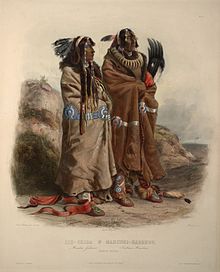The exact origins and early history of the Mandan is unknown. Early studies by linguists gave evidence that the Mandan language may have been closely related to the language of the Ho-Chunk or Winnebago people of present-day Wisconsin. Scholars theorize the Mandans' ancestors may have settled in the Wisconsin area at one time. This idea is possibly confirmed in their oral history, which refers to their having come from an eastern location near a lake.
Ethnologists and scholars studying the Mandan subscribe to the theory that, like other Siouan-speaking people (possibly including the Hidatsa), they originated in the area of the mid-Mississippi River and the Ohio River valleys in present-day Ohio. If this was the case, the Mandan would have migrated north into the Missouri River Valley and its tributary the Heart River in present-day North Dakota. That is where Europeans first encountered the historical tribe. This migration is believed to have occurred possibly as early as the 7th century but probably between 1000 CE and the 13th century, after the cultivation of maize was adopted. It was a period of a major climatic shift, creating warmer, wetter conditions that favored their agricultural production.
After their arrival on the banks of the Heart River, the Mandan constructed several villages, the largest of which were at the mouth of the river. Archeological evidence and ground imaging radar have revealed changes in the defensive boundaries of these villages over time. The people built new ditches and palisades circumscribing smaller areas as their populations reduced.
